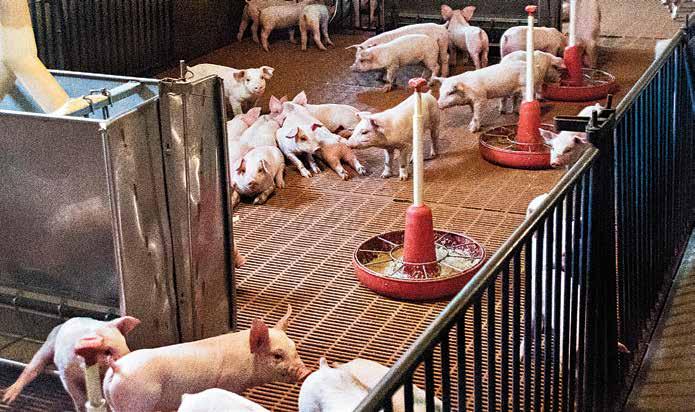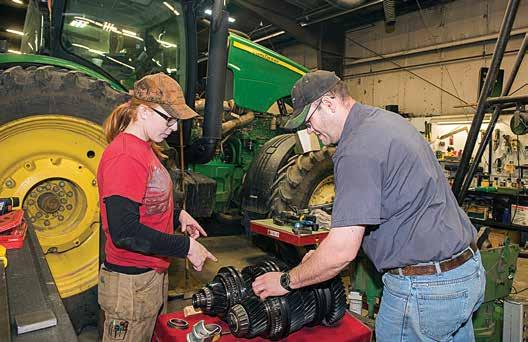
7 minute read
Illinois pork producers could lead a record year
by Shaw Media
Despite all the talk of factory farms, statistics show there are still a lot of family trees in farm fields
Story by Martha Blum AgriNews Publication s/ Shaw Media KANSAS CITY, Mo. — Family farms represent 98 percent of all farms and 88 percent of production in the United States.
Those numbers are included in the “America’s Diverse Family Farms — 2019 Edition” report which describes characteristics of the 2 million farms.
“The report includes what the farms produce, farm profitability, receipts of government payments and participation in agricultural federal programs, which is important to understanding the farm sector,” said Christine Whitt, agricultural economist for the U.S. Department of Agriculture’s Economic Research Service (ARMS).
The data included in this report was collected in the 2018 Agricultural Resource Management Survey.
“ARMS is USDA’s primary source of information on farm businesses and associated household principal operators,” Whitt said. “Principal operators are those who are most responsible for running the farm.”
USDA defines a farm as any place that sold at least $1,000 worth of farm products in a given year. “The farm sector consists of a wide variety of farms — very small farms with little sales, mid-size farms with hundreds of thousands of dollars worth of sales and large farms with millions of dollars of sales,” Whitt said. “A family farm is any farm where more than 50 percent of the business is owned and operated by an operator and individuals related to one operator,” Whitt said.
“The majority of farms are small family farms, but largescale farms have the largest share of the value of production,” Whitt said. “Small farms represent 90 percent of all farms, 48 percent of acres operated and 21 percent of production, whereas largescale family farms represent 2.7 percent of farms, but account for the largest share of production, at 45.4 percent on 19.5 percent total acres operated.”
Small farms produce 56 percent of poultry production, which includes eggs, as well as 50 percent of the U.S. hay production.
“Midsize and large family farms account for the majority of cotton, cash grains and
“Protecting Your Investment In Farmland” SM
oilseed production,” Whitt said. “Large-scale family farms produce the majority of dairy, and non-family farms and large-scale farms produce the bulk of high value crops and beef.”
Many family households combine farm and off-farm income. “Over 41 percent of U.S. family farmers fall into the off-farm occupation typology class and over 80 percent of those operators work off farm as do 60 percent of their spouses,” Whitt said.
“Principle operators of large-scale family farms are less likely to work off the farm than operators of small and midsize family farms — 11 percent of principal operators of large farms and 3 percent of very large farms held offfarm jobs,” Whitt said.
“The majority of spouses of principal operators reported health care benefits are one of the reasons for working off the farm,” Whitt said.
Occupations of operators who work off the farm are different from the general U.S. workforce.
“Among operators of commercial and intermediate farms who also hold an offfarm job, 15 percent to 18 percent are working in farming, fishery or forestry occupations compared to 1 percent of the U.S. workforce,” Whitt said. “In general, farm operators are more likely to work in goods-producing occupations and less likely to work in service occupations.” Most payments from commodity related and working land conservation programs go to three groups — moderate sales, midsized and large farms, representing 76 percent working and 72 percent commodity-related payments, Whitt said.

SERVING ALL PRODUCTION AGRICULTURE NEEDS
815-875-2800


Seed & Agronomy – Ashton, Buda, Henry, LaMoille, Ohio, Princeton, Toulon, Varna, Walnut, Walton Energy –Amboy, Buda, Henry, Princeton, Toulon, Varna, Wyoming Structures & Equipment – Princeton Technology & Precision Ag – Princeton Trucking&On Farm Delivery – Buda
Douglas D. Ray, AFM Accredited Farm Manager/Managing Real Estate Broker 815-872-FARM ( 3276 )



The pig nursery is shown at the Sturtevant farm in rural Shannon. Some experts believe U.S. hog production could reach record levels in 2020, with Illinois pork producers sharing in that growth.
Michael Krabbenhoeft/ For North Central Illinois Ag Mag
Illinois pork producers could lead a record year in hog production
Swine breeding inventory has risen
Story by Daniel Grant FarmWeekNow .com U.S. hog production could reach record levels again this year –and a good portion of that growth could occur in Illinois, where the swine breeding inventory reached 590,000 head as of Dec. 1, up 30,000 head from a year ago.
Overall, the national breeding herd totaled 6.46 million hogs as of last month, up 135,000 head from the same time last year, according to USDA’s quarterly hogs and pigs report released Dec. 23.
“This report gives a view of what the supply outlook is for (this) year,” Altin Kalo, senior analyst with Steiner Consulting Group, said during a teleconference hosted by the National Pork Board. “One thing that determines the supply is the size of the breeding herd. And, chances are, we’ll have more hogs down the road,” he noted. “When you look at where the growth came from, the biggest growth was from Illinois.” The anticipated growth of the swine herd continues a trend in recent years. The inventory of all hogs and pigs as of Dec. 1 totaled 77.3 million head, up 3 percent from last year and a record for the quarter.
Efficiency also reached an all-time high as the average pigs saved per litter last quarter totaled a record 11.09 compared to 10.76 the previous year.
In Illinois, all hogs and pigs totaled 5.35 million head last month, up 1 percent from the previous quarter but down 1 percent from a year ago.
Meanwhile, hog slaughter during a recent 28-week stretch increased 5.5 percent from the previous year as more animals moved through the system, Bob Brown, president of Bob Brown Consulting, noted.
“The last year says to me U.S. pork producers started expanding around August 2018, which is about the first we heard the news of ASF (African swine fever) in China,” Brown said.
ASF decimated an estimated half of the swine herd in China, the largest consumer of pork in the world. U.S. pork exports increased there, but the lion’s share of new sales to China were gobbled up by the European Union in the past year as American pork was sidelined due to trade restrictions.
The EU shipped 2.5 times the volume of pork to China through October than the U.S., Canada and Brazil combined, according to Brown.
“The U.S. pork industry is missing out on an unprecedented sales opportunity in China when it most needs an affordable, safe and reliable supply of its favored protein,” said David Herring, president of the National Pork Producers Council. “The United States is the lowest-cost producer of pork in the world but, with tariffs, we are not as competitive.”
Analysts look for increased sales of U.S. pork and higher prices this year. Kalo projects average CME lean hog prices of $70 per hundredweight the first quarter before rising to $86 and $83 in the second and third quarters, respectively.
Brown predicts stronger pork exports and even higher average CME lean hog prices of $75 in the first quarter and then up to $92 by the second and third quarters before settling back to $75 in the fourth quarter this year.
Exports currently account for more than one-quarter of U.S. pork sales.
FIREPLACES

WINDOWS & FLOORING

, , CABINETRY & COUNTERTOPS

Water Street, Peru 815-223-1742
STONE, SIDING, & ROOFING

DECKING

BATHROOMS










